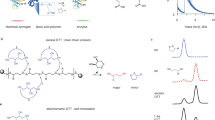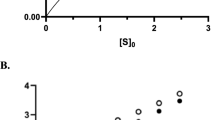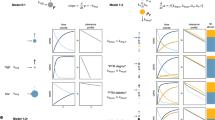Abstract
BERGMANN1 has proposed that proteolytic enzymes mediate in the biological synthesis of proteins from amino-acids. The 400–4,000 2 or more3 calories per mole required for peptide bond formation from free amino-acids can, however, be provided only when synthesis is coupled with an energy-yielding reaction4. To accommodate this energy requirement, Brenner, Hanes, Fruton and co-workers4a have demonstrated that a variety of proteolytic enzymes catalyse a reaction of esters, amides, or peptides (including the naturally occurring peptide, glutathione) with amines or amino-acids in which new amides or peptides are formed. The enzymes show their usual specificity; that is, they synthesize only those peptide bonds that they also hydrolyse. The energy requirement is met by the initial ester, amide or peptide linkage which is split, for there is presumably very little difference in energy between the bond destroyed and that formed. These workers have shown beyond doubt that some or perhaps most proteolytic enzymes can catalyse polypeptide synthesis from amino-acids, providing there is an independent method of ‘energizing’ the amino-acid (ester, amide, peptide, etc.). From there it is possible to speculate that in a similar way these proteolytic enzymes play a part in normal protein synthesis.
This is a preview of subscription content, access via your institution
Access options
Subscribe to this journal
Receive 51 print issues and online access
$199.00 per year
only $3.90 per issue
Buy this article
- Purchase on Springer Link
- Instant access to full article PDF
Prices may be subject to local taxes which are calculated during checkout
Similar content being viewed by others
References
Bergmann, M., “Advances in Enzymology,” 2, 49 (New York, 1943).
Dobry, A., Fruton, J. S., and Sturtevant, J. M., J. Biol. Chem., 195, 149 (1952). Dobry, A., and Sturtevant, J. M., J. Biol. Chem., 195, 141 (1952).
Borsook, H., and Dubnoff, J. W., J. Biol. Chem., 132, 307 (1940).
Frantz, jun., I. D., Loftfield, R. B., and Miller, W. W., Science, 106, 544 (1947). Frantz, jun., I. D., Zamecnik, P. C., Reese, J. W., and Stephenson, M. L., J. Biol. Chem., 174, 773 (1948).
Brenner, M., Müller, H. R., and Pfister, R. W., Helv. Chim. Acta, 33, 568 (1950). Hanes, C. S., Hird, F. J. R., and Isherwood, F. A., Nature, 166, 288 (1950). Fruton, J. S., Symposium sur la Biogenèse des Proteines, IIe Congrès International de Biochimie, Paris, 5 (1952).
Hendler, R. W., and Greenberg, D. M., Nature, 170, 123 (1952).
Zamecnik, P. C., Frantz, jun., I. D., Loftfield, R. B., and Stephenson, M. L., J. Biol. Chem., 175, 299 (1948). Zamecnik, P. C., Frantz, jun., I. D., Cold Spring Harbor Symp. Quant. Biol., 14, 199 (1949).
Stein, W. H., and Moore, S., Cold Spring Harbor Symph. Quant. Biol., 14, 179 (1949).
Sanger, F., and Tuppy, H., Biochem. J., 49, 463, 481 (1951).
Smith, E. L., and Polglase, W. J., J. Biol. Chem., 180, 1209 (1948).
Moore, S., and Stein, W. H., J. Biol. Chem., 176, 367 (1948).
Author information
Authors and Affiliations
Rights and permissions
About this article
Cite this article
LOFTFIELD, R., GROVER, J. & STEPHENSON, M. Possible Role of Proteolytic Enzymes in Protein Synthesis. Nature 171, 1024–1025 (1953). https://doi.org/10.1038/1711024a0
Issue Date:
DOI: https://doi.org/10.1038/1711024a0
This article is cited by
-
Predictive hypotheses are ineffectual in resolving complex biochemical systems
History and Philosophy of the Life Sciences (2018)
-
Dissolution of hypotheses in biochemistry: three case studies
History and Philosophy of the Life Sciences (2016)
Comments
By submitting a comment you agree to abide by our Terms and Community Guidelines. If you find something abusive or that does not comply with our terms or guidelines please flag it as inappropriate.



